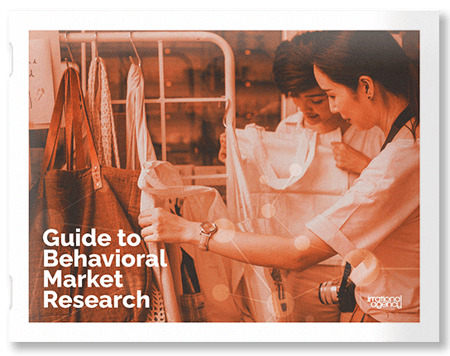
How Irrational Agency's Proven Track Record Delivers Project Confidence
 Irrational Agency
Irrational Agency
Most of us have encountered colleagues, bosses or stakeholders who resisted our new ideas. What is the biggest barrier that holds them back from trying something new?
Psychology gives us the answer: it is the natural human aversion to uncertainty. If someone has never walked a road before, it is difficult to envisage the endpoint. If they can’t visualize something, their mind naturally wants to avoid it. And so people often stick with what they know, the comfortable option - the infamous status quo bias.
This is true in every field, but especially in an area like market research where stakeholders often don’t understand the details of what we do. They often hang on extra tight to the valuable scraps of understanding they have gained over the years, and expect you to keep delivering similar insights in the same format as last quarter.
Does this mean you have to miss out on all the benefits of innovation and the new discoveries you can make? It shouldn’t! You just need to find a way to reassure those stakeholders that a new approach will deliver high quality results - reliably, at low risk. And that is a job your partners who offer new research methodologies should be able to help you with.
The stakes are high. Brands rely on market research for robust data on which to base important business decisions. With big decisions like new product launches and marketing investments in the balance, it's imperative that brands can rely on the outputs of their insights budgets. But maintaining a competitive advantage also means discovering new stories, using new methodologies and new partners. Behavioral economics and behavioral science are a great example: while they are no longer new in themselves, they may still produce results unfamiliar to some brands and marketing teams.
Five ways to give your stakeholders total confidence in a new approach
We want to give you and your organization the choice to use the methodologies that work best for you today - not just those you have been using for years.
So here are five ways to approach new methodologies and reassure your stakeholders they are taking no risks.
Step 1. Follow the leaders: show that the “new” methodology isn’t new to everyone
Every time a new methodology is developed, somebody has to be the first one to try it out. There's a lot of uncertainty involved in its early days since there's no past record to prove that the new approach will produce the desired results. But here’s some good news: if you are trying behavioral research for the first time, you aren’t the guinea pig. Global organizations like Procter & Gamble, PepsiCo and Unilever have dedicated innovation budgets set aside to try new things, and they have been using behavioral science methods for five years or more. Even before that, university psychology and economics departments have been testing these methods for decades.
Irrational Agency has been working alongside them since 2012 to deliver and refine behavioral methods. Indeed, we were the first market research agency dedicated to behavioral science methods (and proud to have been followed by many more!)
Behavioral science today is no longer new: a solid track record of delivery exists across many industries. These tools have matured well beyond the early days, and have now incorporated the highest data quality standards and powerful ways to translate their findings into business action.
While behavioral economics has long been accepted for understanding markets, projecting futures and evaluating the psychology of why consumers buy on a more theoretical basis, market research practitioners have for years been able to apply these in an increasingly specific way to understand product categories and predict active consumer behavior.
The longest-established behavioral methods explore the consumer’s System 1 and System 2 thinking. But it’s true that there is always something new and more powerful on the horizon: an example is the framework that emerged in 2018 for understanding System 3 thinking. So there are still novel applications of behavioral science in the market research space, and just relying on track record may not always be enough to answer all of your stakeholders’ questions.
Step 2. Stay Balanced: A Multitude of Research Methodologies
Behavioral science tools are just that - a set of many tools - and at Irrational Agency, we keep a toolbox of about 10 behavioral science methodologies. We don’t reach in immediately for a tool, but start with a deep analysis of the business question and choose the one or two best-suited approaches.
For example:
![]() If a client has a question related to pricing and promotions, we'll use a tool called behavioral conjoint and employ our Shelf Choice Simulator, recreating the experience of going into a real environment and buying products.
If a client has a question related to pricing and promotions, we'll use a tool called behavioral conjoint and employ our Shelf Choice Simulator, recreating the experience of going into a real environment and buying products.
![]() If the question is more strategic, for example, the nuances of sustainability in the world of beverages and what that means to consumers, we'd use a narrative research approach based on our System 3 methodology.
If the question is more strategic, for example, the nuances of sustainability in the world of beverages and what that means to consumers, we'd use a narrative research approach based on our System 3 methodology.
![]() If the project calls for an even more exploratory approach where a client wants to understand how consumers think but is not sure how to ask the question yet, we might use therapeutic qualitative interviews to immerse ourselves in conversations with respondents, or follow them for a few weeks using mobile ethnography to see how they're using the product.
If the project calls for an even more exploratory approach where a client wants to understand how consumers think but is not sure how to ask the question yet, we might use therapeutic qualitative interviews to immerse ourselves in conversations with respondents, or follow them for a few weeks using mobile ethnography to see how they're using the product.
This consultative approach is an indication that seasoned research professionals know how to match science with desired outcomes. With experience in brain scanning, facial coding, implicit association test, and virtual reality and many more, our teams are well-versed in uncovering or amplifying the truth of a matter - it’s not about choosing a familiar methodology or forcing a client through a standardized series of research projects. This bespoke method has worked for over 10 years, delivering repeatedly for global brands like Coke, IHG, Sanofi-Aventis, and more.
We consider ourselves not just users of behavioral science. We are behavioral scientists, responsible for leading the way in innovations to improve the lives of humans both individually and collectively. We promote our behavioral science agenda through continued original scientific research published in some of the leading academic journals placing us in a unique position to test and evaluate new methodologies as they emerge.
So you can reassure your stakeholders that these innovative methodologies have been selected, by the top experts, to answer their specific business question. Nobody is pushing a new method for its own sake.
Step 3. Show that Behavioral Science Enables Quality Decision-making
Behavioral science incorporates all of the best and traditional quality controls, the statistical reliability of traditional research, and adds an extra level of understanding that is ignored in traditional research: the understanding of unconscious biases and the differences between what people say and what they do. When you are asked, "Can we afford to do this?" the answer should be, "Can we afford not to?" While stakeholders may need to be reassured that behavioral science provides reliable results, the reality is that we now know non-behavioral research cannot provide accurate insights.
Step 4. Visualization: Leverage System 3 Thinking
System 3 is at the heart of Irrational Agency's range of methodologies. System 3 is the brain’s function responsible for imagination, telling stories, mentally visualizing choices before you make them. But this is not limited to how consumers buy your product. It is also part of how your stakeholder’s brain works!
Take advantage of this by helping them to visualize the outputs of the research. It is much easier for stakeholders to believe in something when they can see or hear what it will look like. Showing example outputs - from past projects, or templates - removes a huge source of uncertainty and allows stakeholders to emotionally buy into the approach. Indeed, this often excites their curiosity, making them extra keen to sponsor a project.
When we work with consumers, we use a form of narrative research, leveraging System 3 thinking, as a way to understand the stories that consumers rely on in their daily decision-making and to get that fundamental map of what consumers care about, what makes them feel good when they're choosing your products, and what their expectations of products/services are. You can use the same technique on stakeholders: tell them stories about the other companies who have used this style of research; ask them to share their own stories about new insights and new innovations that have worked for them before.
System 3 is also at the core of one of the main ideas Irrational Agency uses regularly to understand the modes of consumer decision-making within the Think-Feel-Do framework:
![]()
'Think' is the initial shallow first impression that consumers have.
![]()
'Feel' is how the product/service sits within their minds, where consumers' habits live.
![]()
'Do' is how consumers use the product/service.
'Feel' is at the core of this metaphor as it helps create the best picture and fundamental understanding of how consumers feel through System 3 thinking. Our System 3 framework is based on the latest neuroscience research and has been used by companies like PepsiCo, Primark, Clorox, and Sainsbury's. Once again, helping your stakeholders feel good about the research through storytelling will help them buy into the approach.
Research agencies generally go straight from the 'think' to 'do' stages, but don’t have good tools to measure 'feel' and miss out on hearing the stories that matter.
Step 5. Research Ju-Jitsu: Use the Participant-led Approach and let Stakeholders Persuade Themselves
Relying solely on traditional qualitative methods, asking the same questions from each respondent in in-depth interviews, will yield shallow insights. By allowing participants to lead the conversation, research has the potential to discover so much more. It lets the respondent open up, tell their own stories, and lead the conversation. Researchers are guaranteed to discover things they weren't expecting just by letting respondents talk about what their world looks like and not forcing them through the discussion guide questions.
Once again, a method designed for consumers can be adapted to help your stakeholders persuade themselves to try a new approach. Just let them talk! Ask them about problems they encountered with the old method. Let them tell you all their complaints about research (don’t take it personally…it was probably your predecessor’s fault.) Eventually they will talk themselves into the importance of trying a new method.
Want to learn more? You're in luck.


